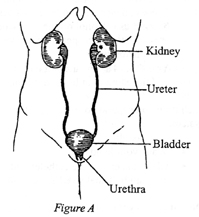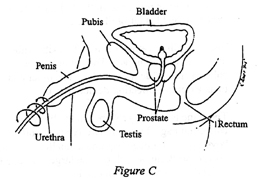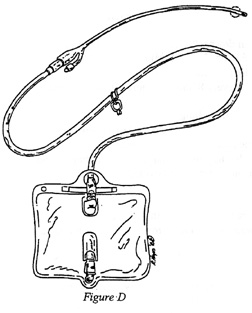Urinary Indwelling Catheter Tips
This booklet will help you in caring for an urinary indwelling catheter at home. It will answer many of your questions. Please ask any other questions that you may have.
Introduction
To understand how the urinary catheter works, you need to become familiar with the urinary system (Figure A).
 The system’s main purpose is to remove urinary waste products from the body. Urine is produced in the kidneys, moves through the ureters and is stored in the bladder until urine is emptied.
The system’s main purpose is to remove urinary waste products from the body. Urine is produced in the kidneys, moves through the ureters and is stored in the bladder until urine is emptied.
The indwelling catheter is a soft flexible tube that is passed through the urethra into the bladder. The catheter is held in place by inflating the balloon end inside the bladder. The other end of the catheter is connected to an external collection device (bag).
The urine is no longer stored in the body but flows continuously into the collection bag. There are two types of collection devices: a large “overnight” drainage bag and a smaller leg bag. The leg bag is used when you are walking or sitting. The large drainage bag is used when you sleep or lie down for more than one hour.
How to Care for Your Indwelling Catheter
 You will need to clean the area around the catheter once a day. This will help prevent bacteria from entering your bladder. (See the area marked by the arrow in Figure C.)
You will need to clean the area around the catheter once a day. This will help prevent bacteria from entering your bladder. (See the area marked by the arrow in Figure C.)
- Begin by washing your hands.
- Clean the area where the catheter enters your body (or tip of penis) with a wash cloth and mild soap and water. Rinse the soap off with water.
- Now clean the catheter. Use a wash cloth and mild soap and water. Start where the catheter leaves your body and wash along the outside of the catheter for three to four inches.
- Secure the catheter with tape or a Dale™Foley Catheter Holder to the outer side of your thigh. Allow enough slack so that the catheter will not pull when you move your leg.
- You will notice dried crusts around the outside of the catheter. These can be removed by gently wiping with a wet wash cloth. (Do not use alcohol on the area where the catheter enters the body or on the tip of the penis; this is very drying to the skin and can cause irritation.)
- You should apply antibiotic ointment around the tip of the penis and the catheter at least four times a day.
Each time you separate or reconnect the catheter from the drainage system;
- Wash your hands.
- Clean the end of the catheter and the end of the drainage tube with a cotton ball soaked in 70 percent rubbing alcohol.
Do not clamp your catheter.
Also, see a novel approach to catheter care or Frequently Asked Questions – Continence (Urinary Concerns).
Collection Devices
How to Change from a Drainage Bag to a Leg Bag
 Wash your hands.
Wash your hands.- Attach one strap of the leg bag to your leg.
- Start with the lower strap.
- Clean the connection between the catheter and the drainage bag with an alcohol swab.
- Gently tap the connection to drain any urine left in the tube down into the bag.
- Hold the catheter with one hand. Grasp the tubing with the opposite hand. Work the connection loose by using your thumb to push up on the end of the catheter.
- Pinch the catheter closed and pull the drainage bag tubing out. Insert the leg bag tubing into the catheter.
- Attach the second strap of the leg bag to your leg.
- Empty the drainage bag and rinse it with cool water.
How to Change from a Leg Bag to a Drainage Bag
- Wash your hands.
- Take off the top strap.
- Clean the connection between the catheter and the leg bag with an alcohol swab.
- Gently tap the connection to drain any urine left in the tube in down into the leg bag.
- Hold the catheter with one hand. Grasp the tubing with opposite hand. Work the connection loose by using your thumb to push up on the end of the catheter.
- Pinch the catheter closed and pull the leg bag tubing out. Insert the drainage bag tubing into the catheter.
- Empty the drainage bag and rinse it with cool water.
Special Instructions
- Wear the larger drainage bag at night. Never go to bed with the leg bag on. Urine could backflow into the bladder if the bag fills up.
- Before taking a nap, empty the leg bag. It is preferred that you wear the night drainage bag when lying down.
- Urine must always drain downhill. Always keep the leg bag, drainage tube and bedside bag below level of your bladder.
- Avoid kinks in the drainage system.
- Empty your bags at least every 8 hours or more often as needed to prevent urine back up.
- While in bed, don’t lie on the tubing.
- Keep everything clean. After cleaning the drainage bags, hang the bag in the shower or bath tub to dry out between use.
- Once a week, rinse the leg bag and drainage bag, including tubing, with vinegar to reduce odor. Use 2 parts vinegar to 3 parts water.
To prevent infection:
- Wash your hands before handling the catheter.
- Tape the catheter in place to prevent it from moving in and out as much as possible.
- Drink sufficient liquids to keep your urine flowing freely and prevent your catheter from becoming clogged.
- It is all right to shower with the catheter in.
When to Call Dr. Catalona
Notify your doctor if any of the symptoms listed below occur.
- Temperature above 101.5°F
- Chills
- Pain radiating from the back to the side
- No urine output in two to three hours
- Urine leaking around catheter
- Catheter comes out

